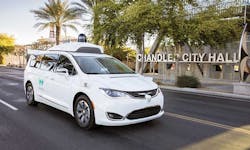For Autonomous Vehicles, The Road Ahead is Paved With Data
This is an updated version of a story that initially appeared in Interglobix Magazine, the publication for data centers, connectivity and lifestyle.
The road to the self-driving car of the future is paved with hardware and data centers. Autonomous vehicles promise to be one of the transformational technologies of the 21st century, with the potential to remake much of our urban and economic landscape.
But many questions remain about how the connected car of 2019 will evolve to meet the vision for the autonomous vehicles of the future, and tough issues to be resolved on multiple fronts – including technology, regulation and infrastructure.
The long-term vision is to create networks of connected vehicles that “talk” to one another using vehicle-to-vehicle (V2V) communications over low-latency wireless connections, which can also allow vehicle-to-infrastructure (V2I) that enable robot cars to connect with traffic lights and parking meters. At present, there are dueling visions for the wireless technologiy that will allow autonomous vehicles to communicate.
The transition to autonomous cars will be gradual, occurring in phases and at a variable pace in different geographies, based on local regulation and the availability of connectivity and data storage to support these services. One thing is certain: The cars of the future will create huge volumes of data, and that will create demand for digital infrastructure to support the industry’s growth.
Lots of Data in Lots of Places
The progress of autonomous vehicle projects has been uneven, as seen in recent headlines. Last week Google’s Waymo division said it would begun using fully driverless minivans – with no support driver – in a ride-sharing service it operates in the Phoenix area. Meanwhile, startup Optimus Ride launched a shuttle service in Reston, Va. featuring low-speed autonomous vehicles.
At the other end of the spectrum was Tesla’s rollout of a “smart summon” feature of its self-driving software, which quickly became the star of viral videos suggesting the beta technology (and maybe some of its users) may not be smart enough just yet.
Autonomous vehicles are the equivalent of supercomputers rolling down the highway, generating and transmitting a mind-boggling amount of data – up to 4 terabytes per day, per car. Most analysts expect the data requirements of self-driving vehicles will be split, with some duties managed by powerful on-board computers, and others offloaded to external facilities for additional data-crunching and storage.
As driverless vehicles take to the roads, they will require low-latency wireless connections to fiber networks and data centers. This connectivity, storage and data-crunching infrastructure may need to extend to almost everywhere cars can drive.
Read more: Uber Prepares for Major Data Center Expansion. (Photo: Uber)
The data center impact of connected cars can already be seen in the compute needs of leading ride-sharing and logistics services.
Ride-sharing service Lyft has run on Amazon Web Services since its launch in 2012, and plans to spend more than $300 million to run IT infrastructure on AWS through 2021, the company said in recent SEC filings. Lyft uses AWS’ auto-scaling feature to ramp its capacity up and down, matching its infrastructure to the volume of its business. Lyft says its Saturday night peak volume is 8 times higher than activity just hours later on Sunday morning.
Uber has charted a different course, working with wholesale data center providers to lease space for its rapid global expansion. The company’s data center team has defined a 5-megawatt deployment that will serve as the building block for the company’s network. Each zone features 10,000 to 15,000 square feet of data center space, leased on a five-year term, with a right of first refusal on 5 megawatts of adjacent space. A zone contains 576 racks, which are divided among standardized groupings of hardware for base compute, storage and machine learning.
Creating The Automotive Edge
The automotive sector is shaping up as a potential game-changer for edge computing. To meet this challenge, the Automotive Edge Computing Consortium (AECC) was formed in 2018 to develop strategies for moving big data between vehicles, edge data centers and the cloud. AECC founding members include AT&T, Intel, Ericsson, NTT, KDDI and Sumitomo Electric.
The AECC estimates that data traffic from autonomous vehicles could surpass 10 exabytes per month by 2025 – about 1,000 times the present volume.
“The present network deployments and business models do not yet support the future needs of connected vehicles,” the group said in a white paper. “There will be a need for new network architectures and computing infrastructure to support massive computing resources and topology-aware storage capacity in terms of balancing quality and cost.
“Our aim is to deploy this redesigned system architecture on a global scale, which will require collaboration among worldwide partners and the system architecture to comply with the relevant standards.”
Startups like Vapor IO and EdgeMicro are deploying the early phases of edge computing networks incorporating micro-data centers, enclosures offering between 48 kW and 300 kW of compute capacity. These modules are designed to be deployed on rooftops and cell tower sites.
Another connection point will be charging stations deployed by electric vehicle manufacturers. Tesla and other electric vehicles are equipped with wireless connectivity to enable “over the air” updates to software.
Charging stations offer the opportunity for batch uploads over fast Wi-Fi connections to offload trip data, and download video, audio, map updates and other data-intensive digital services.
In April, Tesla CEO Elon Musk said the company would soon add free WiFi at all of its 12,700 Supercharger stations that offer rapid charging on popular routes. The company also operates a global network of 22,000 “destination chargers” at hotels, malls and movie theaters. There are also public party charging options like EVgo, whose network of more than 1,000 fast chargers is used by BMW, Nissan and GM owners.
Designed and built by Tesla, Supercharger stations charge Model S, Model X and Model 3 in minutes rather than hours. They will also soon offer free WiFi. (Image: Tesla)
Competing Standards for Future V2V, V2I Traffic
V2V technology is crucial to hopes that autonomous vehicles can dramatically reduce traffic congestion in major cities, integrating location-aware cars, traffic lights and toll gates to enable seamless merging at speed, easing the backups seen at intersections and toll plazas.
- DSRC (Dedicated Short-Range Communications) is based on the 802.11p WiFi standard, and can support very low-latency, secure transmissions, and the ability to handle rapid and frequent handovers seen in a V2V environment. DSRC is also highly robust in poor weather conditions.
- Cellular V2X (C-V2X) uses the existing cellular long-term evolution (LTE) network and eventually the new 5G wireless standard. Its backers say it can also support reliable, real-time communication at high speeds in high-density traffic.
DSRC has been eyed for automotive use since 2004, when the FCC dedicated 75 MHz of bandwidth at 5.9 GHz to be used for vehicle safety and other mobility applications. It has had strong support from General Motors and Toyota, who have installed DSRC equipment in some of their newer vehicles.
But the competing C-V2X technology has gained momentum, with strong support from mobile operators and equipment makers, including Intel, Ericsson, Nokia and Qualcomm. Automakers BMW, Audi and Daimler also support C-V2X. Backers of C-V2X point to limited real-world adoption of DSRC.
Read More: Autonomous Cars Could Drive a Deluge of Data Center Demand
In January, Ford announced plans to install C-V2X support in all new U.S. models by 2022. ““Our hope is that this would spur others to potentially reassess and, in other cases, decide on this direction,” said Don Butler, who heads Ford’s connected vehicle platform, in an interview with Bloomberg. “We’ve been looking at DSRC for a number of years along with Toyota, GM and Honda, so this is not a step that we take lightly in the sense of dismissing DSRC. But we think this is the right step to make given where we see the technology headed.”
Ford’s move seems to have indeed shifted the landscape. In April, Toyota said it was halting plans to install DSRC in its new vehicles, citing “the need for greater automotive industry commitment as well as federal government support to preserve the 5.9 GHz spectrum band for DSRC.”
Changes in Washington are a factor. The Obama administration supported DSRC and backed a mandate that would force automakers to standardize on DSRC, but the Trump administration has been vocal in its support of 5G, and FCC chair Ajit Pai has advocated opening up the spectrum reserved for DSRC to other uses, including C-V2X.
Mobile Micro Clouds
At the DataCloud Edge conference last fall in Austin, Toyota researcher Onur Altintas laid out a vision for “vehicular micro-clouds” that coordinate their movement through low-latency communications.
Altintas, a fellow at the Toyota InfoTechnology Center in Mountain View, Calif., noted that the industry has yet to standardize how to handle data moving between vehicles from competing automakers. He said automotive OEMs are working to define what data will be shared with other vehicles in “micro clouds” and what data will be kept private.
Micro-clouds can be organized in two models:
- Stationary Micro-Cloud: This approach anchors the cloud to a geographic region, in which cars join the micro-cloud when entering the region and hand-off data & tasks when exiting. Parked cars can also be part of the micro-cloud.
- Mobile Micro-Cloud: This approach features an ad-hoc formation, with one vehicle serving as a “cloud leader” that recruits cloud members and distributes sub-tasks for collaborative task execution. The micro cloud moves along roads with the motion of the cloud leader.
The micro-cloud approach supports more efficient data flow because data moves across low-latency connections between physically adjacent cars, rather than a longer route across the network to a regional edge data center or even a distant core data center.
About the Author


